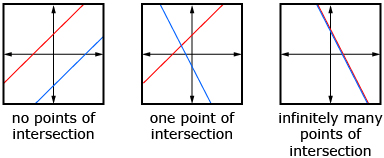Lesson 5
1. Lesson 5
1.4. Discover
Module 4: Quadratic Equations and Inequalities
Discover
The following graphs show the different ways two linear functions can be sketched on the same set of axes.

In Try This 1 you will construct all the ways that quadratic functions and linear functions can be sketched. You will need to use graph paper. You can use Four Grids or use your own graph paper.
Try This 1
Part A: Linear-Quadratic System
- Think about the number of ways that a parabola and a line can intersect on the coordinate plane. For each of the ways this can happen, sketch a possible graph.
- Consider the following system of equations:
y = x2 + 4x − 1
y = x + 1
-
Why do you think this is called a linear-quadratic system?
-
How many solutions are possible for this system?
-
How could you determine the solutions?
-
Part B: Quadratic-Quadratic System
- Think about the number of ways that two parabolas can intersect on the coordinate plane. For each of the ways this can happen, sketch a possible graph.
- Consider the following system of equations:
y = x2 − 6x + 13
y = –2x2 + 12x − 14
-
Why do you think this is called a quadratic-quadratic system?
-
How many solutions are possible for this system?
-
How could you determine the solutions?
-
![]() Save your work in your folder.
Save your work in your folder.
The concepts you have explored here represent the basis of this lesson. You will work with these concepts further in the remainder of the lesson.